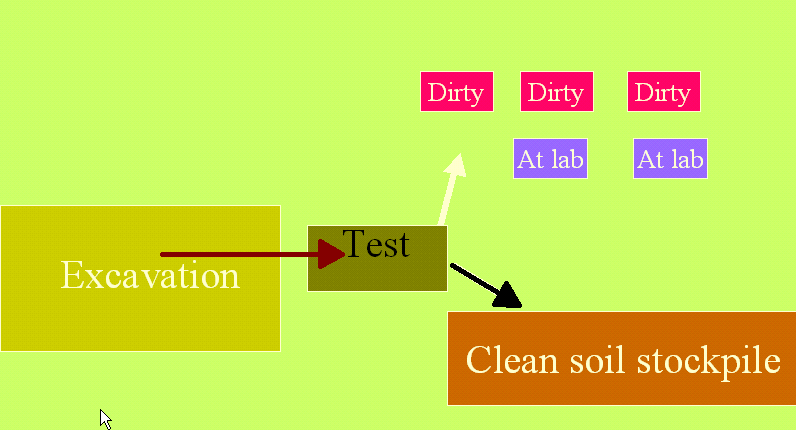
Learning Goals
Learn the Main methods of handling contaminated soil.
Distinguish Land Treatment from Land Disposal
Soil Contamination
A common scenario of improper HW disposal is that some type of liquid or semiliquid gunk is dumped on the ground. Often the volatile components evaporate and the liquid components percolate into the ground. In the past this process was exacerbated by the dumper digging a pit or trench for the waste, then covering it. This retarded volatilization and aided percolation. Depending on the nature of the liquid waste, the soil, and the rainfall, the contaminant liquids often reached the groundwater, which is the topic of the next submodule. Often significant portions of the waste remain in the soil, often for very long periods of time. From its location in the soil matrix, the contaminant was a threat to persons via dust inhalation, dust ingestion, dermal contact, both from the soil's current status and via future earth moving or construction operations. It was often a continuing threat to groundwater, as percolation continued or rainwater leached the contaminant. Remediation of "dirty dirt" is a growth industry: old waste sites are constantly being located, leaking underground tanks are discovered, and spills from transportation accidents are sources of new business.
Once the location and extent of soil contamination are ascertained (at least approximately), there are two main options for treatment. One is in place (in situ) treatment, the other is excavation. If the threat to groundwater is not severe, economics will likely determine if in situ treatment will be used. If the threat is severe, the soil must be excavated, if that is practical.
Excavation
Here is a typical dirty dirt operation:

The excavated soil is tested, perhaps by the truckload. Or it may be placed by excavator bucket in one location and piles of reasonable dimensions formed, then these are tested with a "field screening test" of some sort. If the test indicates the soil is not contaminated, it is scooped up and taken to a clean soil stockpile. If the test indicates it is contaminated, it is scooped up and taken to piles that are known dirty. If the field screening test is not conclusive, samples are taken for off-site laboratory testing and that soil is moved to holding piles. The details of this process, the size of piles, the amount of field testing, the qualifications of the personnel doing the testing, and such details are decided by the PRP and approved by the regulators before the process starts. One item that is always in the plan is that all the dirty and suspected dirty soil be placed on watertight plastic liners.
The soil that does not meet acceptable standards for the contaminant concentration will be treated or disposed. We'll talk about treatment below. Often, even in remote Alaska locations, it is cheaper to haul the dirty soil to a treatment and storage facility than to treat it in place or on site. These treatments take a long time and require periodic monitoring, reports, and inspections. These costs add up as the years go by, so paying the up front money to have it hauled away is often better economics.
Your textbook has some fundamentals of land application or "land farming." For most troublesome contaminants, the farming process takes place on top of an impermeable membrane or liner. For less troublesome contaminants this might be done with the contaminated surface soils in situ. The philosophy is to let the soil microorganisms metabolize the waste. If the waste has been in place for a while (we have cleanup fuel spills over 20 years old - which still had significant levels of benzene in them) the local soil microorganisms have been metabolizing the waste and all that is needed is to optimize their environment by adding nutrients, perhaps adjusting the pH, and adding oxygen, typically by tilling. See below. In other cases, special microorganisms are added. Often these are patented "bugs" reputed to "eat" difficult wastes such a chlorinated solvents and pesticides.
The notion of "natural attenuation" should be mentioned. For many contaminants, petroleum for example, concentrations at the spill site will decrease with time. This is good, if they are being metabolized by microorganisms. Less good if they are migrating into the air or groundwater. For other contaminants, PCBs for example, this natural process is very slow, lasting centuries. Simply leaving contamination in place is not "treatment" but is often an option. Indeed, it may be the only practical solution. The decision to permit natural attenuation is up to the regulators. If it is granted, it always has a strong requirement for monitoring and reporting, and the regulators reserve the option of requiring something else be done at a later date, if conditions warrant. Here is a neat brief exposition of natural attenuation.